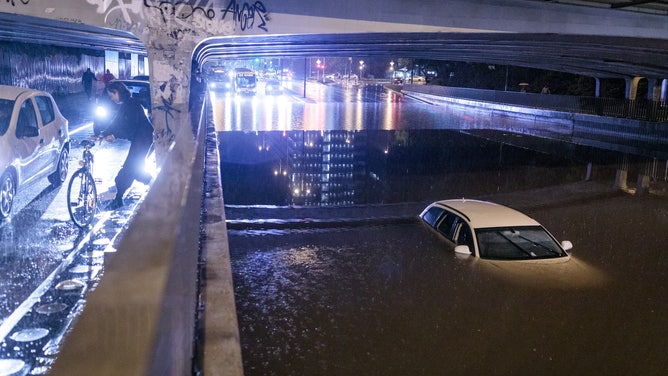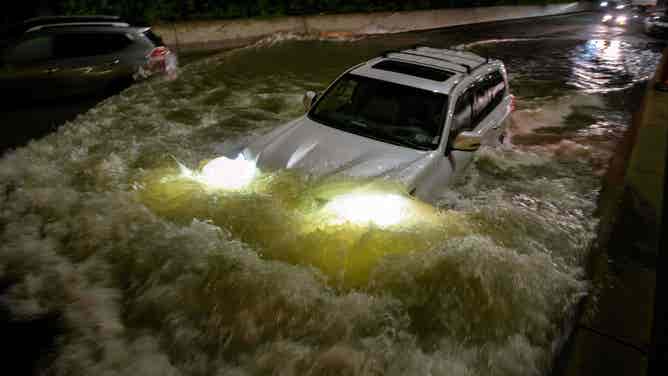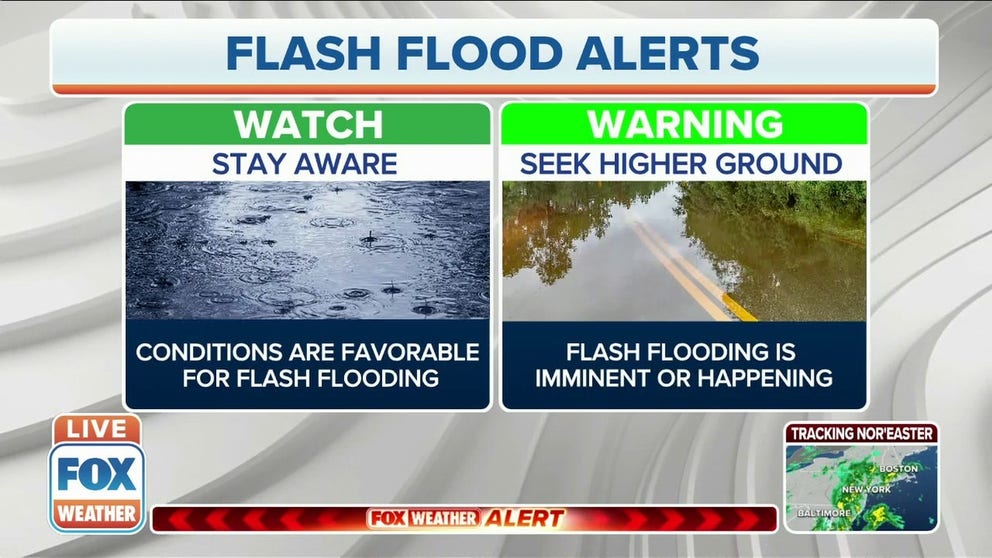7 facts you should know about flash floods
Flash flooding kills more people per year than hurricanes, tornadoes and lightning
FOX Weather explains: Flood Safety
FOX Weather meteorologists Stephen Morgan and Britta Merwin explain the importance of flood safety.
Flash flooding remains the deadliest severe weather in the U.S., killing more people per year than hurricanes, tornadoes and lightning.
Conditions to produce these powerful floods can happen under various circumstances, but there are warning signs.
What creates a flash flood?
According to the National Weather Service, it isn't just one weather event that creates a flash flood but many elements combined.
The main reason for flash flooding is heavy rainfall, usually over a long period over a dry land area. Next, the conditions of soil, ground cover and topography also factors into flooding. When water exceeds the ability of the ground to absorb it, flash flooding occurs.
Flash floods can happen within minutes of excessive rain or if a dam or levee fails, causing a sudden rush of water.
Most flash flooding is caused by slow-moving thunderstorms repeatedly moving over the same area or heavy rains from hurricanes and tropical storms.

A view of flooded streets after heavy rain in Ljubljana, Slovenia on September 30, 2021. More than 500 workplaces damaged due to heavy rain after 88 litres of rain per square meter fell. (Photo by Ales Beno/Anadolu Agency via Getty Images)
(Getty Images)
Areas most susceptible to flash flooding
According to NASA, some of the most at-risk areas for flash floods include urban areas.
Buildings, highways, driveways and parking lots increase rain runoff by reducing the amount of rain absorbed by the ground, increasing the potential for a flash flood.
The National Disaster Association reports that river flood plains and coastal areas are most susceptible to flooding, but flash floods can happen anywhere with extended periods of heavy rainfall.
Bangladesh is the most flood-prone area globally because of the monsoon season, causing periods of intense rainfall. Deforestation in Nepal, causing soil erosion, has also added to flooding issues.
How powerful are flash floods?
Flash floods can roll massive boulders, flatten full-grown trees and destroy buildings and bridges. It takes just six inches of fast-moving flood water to knock you over, according to the NWS.
Will you know when a flash flood is coming?
When conditions are ripe for a flash flood, the NWS will issue flash flood warnings and watches.
If a flash flood warning has been issued near you, it's time to get to higher ground.
The NWS uses satellites, radar, and rain gauges to predict and detect flooding to look out for weather associated with flash flooding.
Forecasters use radar to estimate rainfall rates and other potential factors as they consider issuing flash flood warnings.
Learn the difference between flood watches and warnings here.
Download the FOX Weather app to get weather alerts for flooding and stay aware of what's happening around you.

A motorist drives a car through a flooded expressway in Brooklyn, New York, early on Sept. 2, 2021, as flash flooding and record-breaking rainfall brought by the remnants of Storm Ida swept through the area. (Photo by ED JONES/AFP via Getty Images)
(Getty Images)
How to avoid deadly flooding
According to the NWS, most flood-related deaths are due to flash floods. It's also the No. 1 weather-related killer in the U.S.
Nearly half of flood deaths are vehicle-related, according to the NWS.
You've probably heard officials warn, "turn around, don't drown." The saying applies to all flooding situations. Don't drive in flooded streets or highways. The general rule is if you can't see the road, it's not a good idea to continue.
If your vehicle stalls in water, abandon it and seek higher ground. Rising water can quickly sweep away a vehicle.
What to do if you are caught in a flash flood
According to FEMA, these are the basic safety rules to follow in the event of a flooding event:
Evacuate if you are told to leave.
Avoid bridges over fast-moving water.
Get to higher ground.
If you become trapped on a roof or higher area, stay where you are and wait for rescue.
Avoid wading in floodwater; it can contain dangerous debris or downed power lines that electrically charge the water.
Historic flash flooding events
Johnstown, Pennsylvania: A dam failed in 1889, sending a flash flood wave through the city, killing 2,200 residents.
Mississippi floods: In April 1993, areas of the Midwest received as much as ten times the average amount of rainfall which swelled the Mississippi and its 50 tributaries. The Mississippi flooded 354 counties in 9 states, destroying bridges and airports and killing 45 people. More than 50,000 people were displaced.
Big Thompson Canyon: In July 1976, a storm dumped a foot of rain into the Colorado canyon, sending a raging flash flood of water 19 feet high, killing 144 people and injuring 250 others, according to the U.S. Geological Survey.
Turkey: Flash floods killed at least 77 people in three provinces in August 2021 after heavy rainfall began on Aug. 10, reports floodlist.com.
